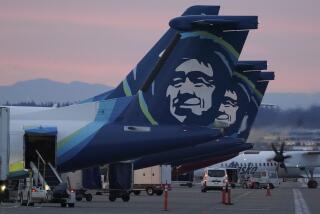Pilot Fought to Control Doomed Jet Up to the End
- Share via
TOKYO — With pieces of tail section tearing away and the hydraulic controls of his jumbo jet gone, Capt. Masami Takahama desperately tried to nurse the wildly bucking craft to a safe landing by manipulating power to its four engines, transcripts showed today.
But the 49-year-old pilot’s special expertise in the technique was not enough, and the Boeing 747 jetliner plowed into a mountain ridge about 70 miles northwest of Tokyo on Aug. 12.
Among the 524 people aboard, only four passengers survived history’s worst single-plane disaster.
While the cause--and much that occurred during the final terrifying minutes aboard Japan Air Lines Flight 123--have yet to be determined, conversations from the plane’s voice recorder show that Takahama and co-pilot Yutaka Sasaki tried to control the jet until the very end.
A preliminary transcript from the recorder, released today by the Transport Ministry, showed that at about 6:35 p.m., 10 minutes after Takahama declared an emergency, he said, “Hydro (hydraulic systems) all out.” The pilot’s voice followed with a series of orders. Then there was the sound of the crash.
Meanwhile, an account by one of the four survivors offered the first solid indication that others aboard the jetliner had survived the crash, only to perish before rescuers reached the scene, nearly 14 hours afterward.
Keiko Kawakami, 12, told reporters in the hospital that her father and a 7-year-old sister were both alive, trapped in wreckage and talking “for a long time” but that both died during the night.
The mass circulation Yomiuri Shimbun said the 12-year-old also reported hearing the murmur of others in the wreckage--people asking each other, “Are you all right?” and urging, “Hang on.”
Takahama, married and the father of two, was an experienced pilot, having logged 12,404 flight hours, including 4,588 in 747s, according to JAL’s senior jumbo jet pilot, Capt. Yoshio Iwao.
Iwao said Takahama had served as a 747 flight instructor for the last three years and was an expert in the “very difficult” technique of flying the huge aircraft by using only increased or reduced throttle power to the engines.
Iwao said altitude changes on radar plottings suggested that the pilot gradually lost control over elevators located on the horizontal tailpiece which are used to climb or descend.
Radio and radar transcripts released by the Transport Ministry show that at 6:25 p.m., 39 minutes before the crash, Takahama told Tokyo air controllers he was declaring an emergency and descending from 24,000 feet to 22,000 feet.
However, radar indicated the plane instead climbed to 24,900 feet in the next two minutes.
“That shows he had difficulty with the elevators, which aren’t known to have blown away. It only could point to an extensive damage to the hydraulic system,” Iwao said.
With his direction controls gone, Takahama probably reduced power to his starboard engines to turn right, or east toward Tokyo, Iwao said, which could account for the aircraft’s wide curve near Mt. Fuji, 62 miles west of Tokyo. Overmanipulation of power, with no stabilizing tail fin, could explain a complete circle minutes later. As far as is known, Takahama didn’t know his rudder and most of the tail fin were gone.
“If it weren’t for Capt. Takahama,” said Iwao, “the aircraft would have plunged into the sea or earth a long time before it actually did.”
Minutes before the Japan Air Lines jet crashed into a mountain, passenger Hirotsugu Kawaguchi dashed notes across seven pages of a pocket calendar, describing his thoughts as he was about to die, Japanese television reported Sunday.
“Be good to each other and work hard. Help your mother,” began Kawaguchi, 52, as most of the 524 people aboard the Boeing 747 scrambled for oxygen masks and life vests.
“I’m very sad, but I’m sure I won’t make it. I don’t know the reason,” Kawaguchi wrote in the notes addressed to his wife, two daughters and a son.
Noting that five minutes had passed since the plane went out of control, he continued, “I don’t want to take any more planes. Please Lord help me.”
More to Read
Sign up for Essential California
The most important California stories and recommendations in your inbox every morning.
You may occasionally receive promotional content from the Los Angeles Times.













